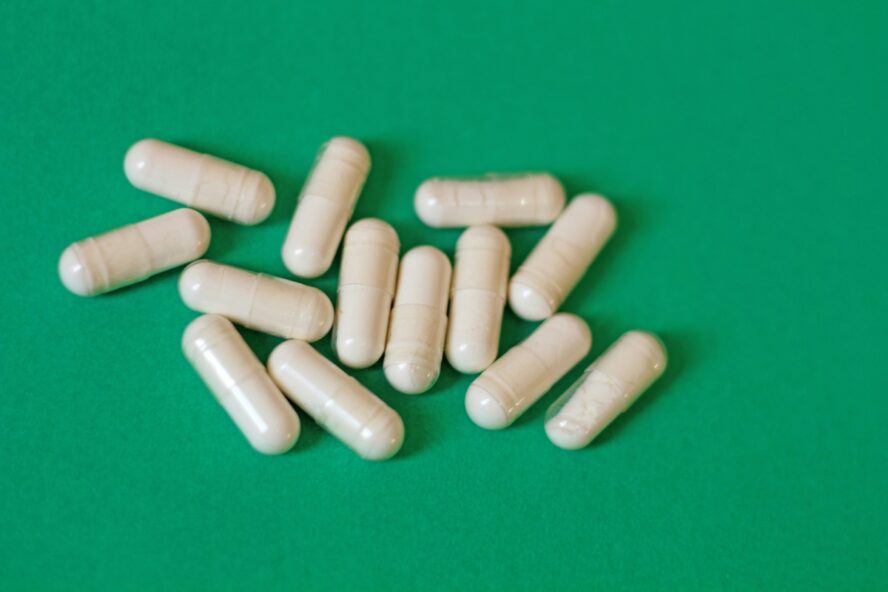
PFAS wear their ‘forever chemicals’ nickname well: Toxic per- and polyfluoroalkyl substances (PFAS), once widely used to make nonstick pans, are pervasive in the environment and even in our bodies. In fact, an analysis conducted by the Centers for Disease Control and Prevention reported that PFAS are present in the blood of a whopping 97 percent of Americans1.
So, can you remove PFAS from your body once it’s there? Two new studies seem to have found a means of counterbalancing this omnipresence: fiber. The collaborative studies found that a soluble fiber supplement could act like a magnet for two of the most common and toxic PFAS, bundling them up and removing them from our bodies as easily as dropping the kids off at the pool.
Is Fiber the Hero in Our Fight Against PFAS?
The two new studies were led by Professor Dhimiter Bello, associate dean of research in the Zuckerberg College of Health Sciences, and Jennifer Schlezinger, Professor of Environmental Health at Boston University, and published in Toxicology and Applied Pharmacology2 and Environmental Health3. The idea came to Schlezinger when she was attempting to find a way to reduce her own cholesterol without relying on medication.
“As a scientist, I had a life-meets-science [moment],” she says. “In published research studies, I found that consuming gel-forming fibers can increase the elimination of bile acids, which in turn reduces cholesterol in the blood. The liver then pulls cholesterol out of the blood to replace the lost bile acids. It occurred to me that bile acids and PFAS have similar chemical characteristics, and both are recirculated between the liver, the bile and the gut.”
Want more news on forever chemicals? Sign up for the newsletter for more well-researched, non-toxic living guidance and smart wellness advice.
Findings of the Fiber and PFAS Studies

Bello’s lab developed methods for measuring PFAS in human tissues and biological fluids, and together, the researchers led several pilot studies to ascertain the effects of an oat beta-glucan supplement on the absorption of PFAS. After four weeks, they found that the fiber supplement had reduced the absorption of long-chain PFAS like PFOA and PFOS by eight percent.
“By consuming gel-forming fibers such as psyllium with a meal, we can trap PFAS inside the fiber gel, which can then be removed via feces,” explains Bello.
Given the fact that an estimated 80 percent of U.S. military bases are known to have elevated PFAS contamination, the Department of Defense’s Toxic Exposures Research Program has a vested interest in any methods of removing PFAS from the body. The department awarded the team a $1.1 million three-year grant to continue their research.
“We’re still mid-experiment but we’re seeing very promising things,” Schlezinger told the Guardian4. “The key is that this is feasible, accessible and economical.”
The Dangers of PFAS
No one wants toxic chemicals in their body, but PFAS are particularly worrisome. PFAS are a class of about 15,000 chemicals primarily used to make products water- and grease-resistant. Research has linked PFAS exposure to a variety of health issues, including cancer, cardiovascular disease, liver disease, high cholesterol, kidney disease and immune suppression.
PFAS have long been commonly used in nonstick cookware surfaces like Teflon. And while many brands have eradicated PFAS from their formulation, some still use these chemicals (even when they claim not to!), making it all the more important to choose non-toxic cookware for your kitchen.

PFAS are also used in fire extinguishing foams, grease-resistant food packaging, biosolids, and some textiles. People can ingest them by way of foods that have been exposed, like fish, and sources of public drinking water that have been contaminated by pesticides with PFAS. The Environmental Protection Agency announced plans to reduce limits for PFAS in drinking water in March5, more than a full year after the Biden administration finalized national standards that could have reduced PFAS exposure for millions of people.
PFAS Are Bioaccumulative
Although understanding how to avoid PFAS can go a long way towards preventing exposure, it’s not always possible to completely prevent ingestion. PFAS are water-soluble and are thus quite easily assimilated into the body. And once they’re there, their long half-life — between two and five years, according to some estimates6 — means that they’re more likely to have toxic effects.
“PFAS really easily enter the body, but the problem comes in that we can’t break them down, and we can’t get them out of the body,” says Schlezinger. “Something I tell my toxicology students all the time is a key principle in toxicology: the longer something stays in the body, the more likely it is to cause toxicity. So, because PFAS can’t leave the body easily, they build up in concentration.”
The Benefits of Fiber Don’t End with PFAS
These new studies confirm previous research associating increased fiber intake with reduced PFAS absorption. A 2021 study in Environment International found that increasing dietary fiber intake was associated with a more than 3 percent decrease in PFOA and a more than 6 percent decrease in PFOS7.
Similarly, a 2022 mouse study published in Environmental Health Perspectives found that soluble fiber supplementation could reduce certain metabolic effects of PFOS8, and earlier this year, a human trial in Environmental Health found that the benefits of fiber supplements included reduced PFAS concentrations in adult males9.

But that’s not the end of the health benefits of fiber. Consuming fiber has been found to reduce heart disease risk10, regulate immune function11, and protect against certain cancers12. Increased fiber intake is also beneficial for metabolic health, weight control, and gut health.
The major problem? Americans aren’t getting nearly enough. The National Institutes of Health estimates that as little as 5 percent of the American population consumes the recommended level of fiber13.
Soluble Fiber vs. Insoluble: What’s the Difference?
Fiber comes in two forms: soluble and insoluble. Soluble fiber mixes with water to slow digestion. This kind of fiber is associated with a lowered risk of heart disease and lowered cholesterol levels, not to mention the PFAS reduction in the recent research. Insoluble fiber doesn’t dissolve in water and serves to bulk out stool to help waste pass more easily. While PFAS reduction specifically requires soluble fiber, we need a good balance of both for healthy digestion.
Best Sources of Fiber
Great sources of soluble fiber include beans like black beans and lima beans, but you’ll also find it in oatmeal, seeds, nuts, and fruits. Great sources of insoluble fiber include whole grains like brown rice or wheat bran, berries, and skin-on fruits like apples and pears. A combination of both is a great way to promote improved health — and reduce the PFAS in your body at the same time.
Read More on Organic Authority
Sources:
- https://www.niehs.nih.gov/health/topics/agents/pfc
- https://www.sciencedirect.com/science/article/pii/S0041008X24003879?via%3Dihub
- https://ehjournal.biomedcentral.com/articles/10.1186/s12940-025-01165-8
- https://www.theguardian.com/environment/2025/may/11/pfas-dietary-fiber-forever-chemicals
- https://apnews.com/article/pfas-forever-chemicals-trump-zeldin-epa-water-a1c15348e9fc42bd22b10d0329b2f321
- https://www.sciencedirect.com/science/article/pii/S0013935123025471
- https://www.sciencedirect.com/science/article/pii/S0160412020322479
- https://pubmed.ncbi.nlm.nih.gov/36331819/
- https://ehjournal.biomedcentral.com/articles/10.1186/s12940-025-01165-8
- https://tools.niehs.nih.gov/srp/researchbriefs/view.cfm?Brief_ID=303
- https://pmc.ncbi.nlm.nih.gov/articles/PMC10501836/
- https://pmc.ncbi.nlm.nih.gov/articles/PMC7589116/
- https://pmc.ncbi.nlm.nih.gov/articles/PMC6124841/

